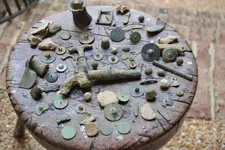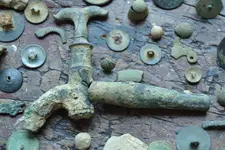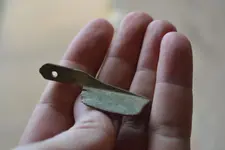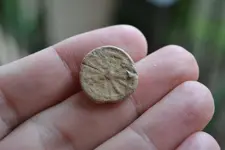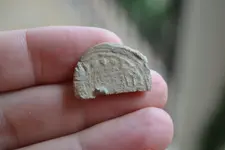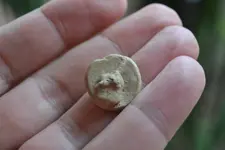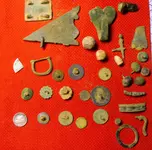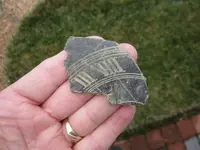HomeGuardDan
Bronze Member
- Joined
- Jul 15, 2011
- Messages
- 1,677
- Reaction score
- 2,473
- Golden Thread
- 5
- Location
- Williamsburg, VA
- 🥇 Banner finds
- 5
- Primary Interest:
- All Treasure Hunting
Colonial goodies - lead for silver and why don't you have a drink....
I got out on Saturday with my good pal Bill D. and my father (who was up visiting) joined us for a day of colonial relic hunting at one of our latest sites. The day started out slow and to be honest, it stayed slow, but consistent all day. I was a little astonished at the total once I cleaned everything up, though we were steadily digging stuff.
While I was not able to get over silver like Bill (his cob) and my father (cut pistareen), I was able to bring home some unique pieces. My favorite piece was this early (1700s) spigot including the key. I hit a nice patch of iron and debris and hunkered down digging a few buttons and other odds and ends. I located the broken key first, then the main valve and searched on and on for the barrel to no avail. A short time later my father walked up and he was holding the missing piece (which he generously gave me) that he recovered on his initial pass through this particular spot.
Earlier in the morning I was hitting an area where a few buttons came from including a very early and crude molded/cast lead button with the shank still intact. A short while later I located what I initially thought was a blob of melted lead until I turned it over. I first thought it was a seal, though I was perplexed as the reverse was nothing more than a melted blob of lead, then after cleaning it off, it appeared to be a pistareen (shield) punched into it. I had recovered an early seated liberty version years ago in a CW camp and thought that this must be the case. However, after more cleaning, now I am unsure...very cool either way. Some angles I see the pistareen and others I don't. I will let you be the judge.
One of my last finds of the day was the portion to an early candle snuffer (I think). These seem to turn up in this area quit a bit as Bill recovered a portion of one a few years back on the same farm and I a stand a mile down the road. The broken candle holder rounded off the day of big finds along with plenty of lead, brass buckles and broken shoe buckles.
My total for the day was 25 buttons (initially thought 24 until I found the broken one mixed in with a bunch of sheet brass). No coin for danny boy, but a pile of colonial goodies none-the-less. I'll get them next time, Bill is now 1 silver coin up on me and a couple of coppers as well - i have some catching up to do.
HH
Dan
I got out on Saturday with my good pal Bill D. and my father (who was up visiting) joined us for a day of colonial relic hunting at one of our latest sites. The day started out slow and to be honest, it stayed slow, but consistent all day. I was a little astonished at the total once I cleaned everything up, though we were steadily digging stuff.
While I was not able to get over silver like Bill (his cob) and my father (cut pistareen), I was able to bring home some unique pieces. My favorite piece was this early (1700s) spigot including the key. I hit a nice patch of iron and debris and hunkered down digging a few buttons and other odds and ends. I located the broken key first, then the main valve and searched on and on for the barrel to no avail. A short time later my father walked up and he was holding the missing piece (which he generously gave me) that he recovered on his initial pass through this particular spot.
Earlier in the morning I was hitting an area where a few buttons came from including a very early and crude molded/cast lead button with the shank still intact. A short while later I located what I initially thought was a blob of melted lead until I turned it over. I first thought it was a seal, though I was perplexed as the reverse was nothing more than a melted blob of lead, then after cleaning it off, it appeared to be a pistareen (shield) punched into it. I had recovered an early seated liberty version years ago in a CW camp and thought that this must be the case. However, after more cleaning, now I am unsure...very cool either way. Some angles I see the pistareen and others I don't. I will let you be the judge.
One of my last finds of the day was the portion to an early candle snuffer (I think). These seem to turn up in this area quit a bit as Bill recovered a portion of one a few years back on the same farm and I a stand a mile down the road. The broken candle holder rounded off the day of big finds along with plenty of lead, brass buckles and broken shoe buckles.
My total for the day was 25 buttons (initially thought 24 until I found the broken one mixed in with a bunch of sheet brass). No coin for danny boy, but a pile of colonial goodies none-the-less. I'll get them next time, Bill is now 1 silver coin up on me and a couple of coppers as well - i have some catching up to do.
HH
Dan
Attachments
Upvote
28

